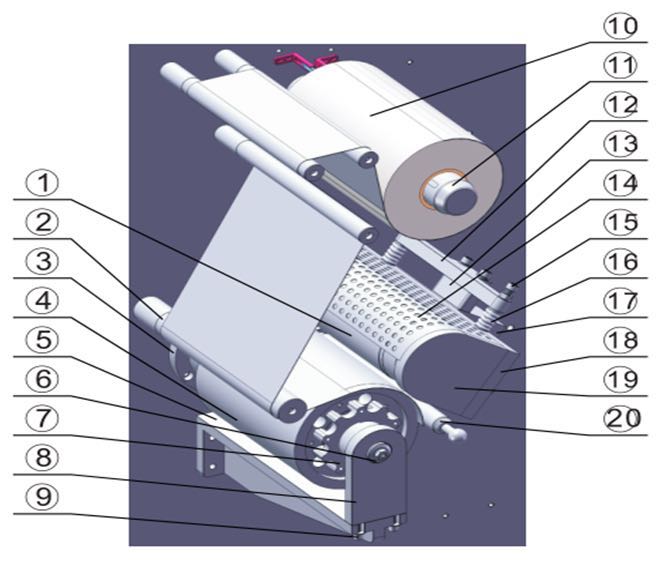DPH series Blister Machine-the sealing station
The Blister Packaging Machine, in the sealing station, the lidding foil is sealed to the formed blister material to create a protective barrier around the product. The Blister Packaging Machine has two types of blister sealing principle, platen sealing and rotary sealing, this Blister Packaging Machine adopts rotary sealing, the rotary sealing adopts a continuous rolling motion to use heat and pressure to seal the products.
Compared with platen sealing, the rotary sealing has such characters:
.Continuous indexing allows easer blister feeding for simple shaped products, such as flatten table and capsule, it is not suitable for ampoule and vials or other complicated shaped products.
.Dwell time for sealing is shorter, thus the hot air getting into the blister pockets is reduced.
.Smaller space required due to a combination of indexing in one station.
.Reduced wrinkles due to linear contact sealing.
.Very short process time of sealing, so the Blister Machine can run at a higher speed
.Achieved higher sealing pressure with smaller forces due to smaller sealing area (only a linear).
The working principle of the sealing station.
During the running of the Blister Packaging Machine, the heating roller presses the rotary sealing mold (as the picture shown), the heating roller’s temperature is around 220℃, with the continuous indexing, the formed blister enter into the cavity of the rotary sealing mold, under the pressure and temperature the lidding foil is sealed to the formed blister material. When the Blister Machine stops, the heating roller can rise up automatically.
There are 4 aspects can effect the sealing quality:
.Dwell time for sealing, if the time is too short, the glue (adhesive side) in the lidding foil can not be melted enough, so the lidding foil can not affix the forming material strongly; But too long of the time, the hot air will getting into the blister pockets, deforms the blister and may effects the products.
.Temperature, too low temperature can not melt the glue on adhesive side of the lidding foil; But too high temperature will deforms the blister and effects the products, normally the temperature is around 220℃.
.Pressure, the pressure between the heating roller and sealing mold should enough to make clear grid sealing linear, so the lidding foil can be affixed to forming materia, but too high pressure will be harmful to the blister machine, normally the compressed air that provided to cylinder of the heating roller (in the rear side of the machine) should be set around at 0.4 Mpa.
Replacement of the lidding foil reel
When the Blister Machine depletes the lidding foil, we need to stops the Blister Machine and replace a new reel. In this Blister Machine the lidding foil loader (11) adopts a fast lock mechanism, enabling replacement of lidding material very easily, firstly turn the lidding foil loader switch (21) to horizontal position to loosen the lidding foil reel from the loader, take the current reel out from the loader, then put the new lidding foil reel to the loader, finally turn the switch to vertical position to fix the reel.
Replacement of the rotary sealing mold.
To replace the rotary sealing mold, we must to power off the Blister Machine firstly, when the Blister Machine stops, the heating roller (1) can rise up automatically to separate with rotary sealing mold, the heating roller is driven by a cylinder to rise up, so make sure the Blister Machine still connect with compressed air when power off; Block the water inlet, take out the water connection (6); Loosen screw (9) to take out the support seat2 (8) and connect cover (7); Take out the rotary sealing mold (4) from its shaft; Place the new rotary sealing mold to its shaft; Put back the connect cover, water connection, the support seat2, the locking screw, then finish the replacement.
Adjusting of the spring screw (15)
If the sealing grid inprint is not uniform on the sealed web, such as one side is deep the other side is shallow, we can adjust two sides of the spring screws (15), to increase pressure at the shallow side or decrease the pressure at the deep side.
Note: When power off the Blister Machine, make sure the water chiller still works for extra 30 minutes, so the water can continue to protect the bearings in the heating roller from damaging by absorbing heat from heating roller.
The schematic diagram of the sealing station

1.Heating roller 2.Turning Roller 3.Bearing base 4.Rotary sealing mold 5.Support Seat1 6.Water connection 7.Connecting cover 8.Support Seat2 9.Locking Screw 10.Lidding foil 11.Loading Shaft 12.Spring adjusting pedestal 13.Support Seat 14.Protective cover 15.Adjusting Screw 16.Spring 17.Rev Shaft 18.Junction plate 19.Bearing pedestal 20.Handle
